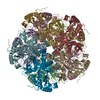[English] 日本語
 Yorodumi
Yorodumi- PDB-9c28: Structure of endogenous Glutamine synthetase from rat model of Al... -
+ Open data
Open data
- Basic information
Basic information
| Entry | Database: PDB / ID: 9c28 | ||||||
|---|---|---|---|---|---|---|---|
| Title | Structure of endogenous Glutamine synthetase from rat model of Alzheimer's disease | ||||||
 Components Components | Glutamine synthetase | ||||||
 Keywords Keywords | LIGASE / Glutamine synthetase | ||||||
| Function / homology |  Function and homology information Function and homology informationAstrocytic Glutamate-Glutamine Uptake And Metabolism / Glutamate and glutamine metabolism / intracellular ammonium homeostasis / ammonia assimilation cycle / protein palmitoylation / protein S-acyltransferase / protein-cysteine S-palmitoyltransferase activity / regulation of protein localization to nucleolus / regulation of sprouting angiogenesis / regulation of endothelial cell migration ...Astrocytic Glutamate-Glutamine Uptake And Metabolism / Glutamate and glutamine metabolism / intracellular ammonium homeostasis / ammonia assimilation cycle / protein palmitoylation / protein S-acyltransferase / protein-cysteine S-palmitoyltransferase activity / regulation of protein localization to nucleolus / regulation of sprouting angiogenesis / regulation of endothelial cell migration / dynein light chain binding / glutamate metabolic process / glutamine synthetase / glutamine biosynthetic process / glutamine synthetase activity / glutamate binding / nickel cation binding / glial cell projection / positive regulation of synaptic transmission, glutamatergic / response to glucose / axon terminus / positive regulation of erythrocyte differentiation / cellular response to starvation / positive regulation of epithelial cell proliferation / cell projection / positive regulation of insulin secretion / myelin sheath / manganese ion binding / ribosome biogenesis / cell body / angiogenesis / perikaryon / cell population proliferation / magnesium ion binding / endoplasmic reticulum / protein-containing complex / mitochondrion / ATP binding / identical protein binding / plasma membrane / cytoplasm / cytosol Similarity search - Function | ||||||
| Biological species |  | ||||||
| Method | ELECTRON MICROSCOPY / single particle reconstruction / cryo EM / Resolution: 3.12 Å | ||||||
 Authors Authors | Khalili Samani, E. / Keszei, A.F.A. / Mazhab-Jafari, M.T. | ||||||
| Funding support |  Canada, 1items Canada, 1items
| ||||||
 Citation Citation |  Journal: Structure / Year: 2025 Journal: Structure / Year: 2025Title: Unveiling the structural proteome of an Alzheimer's disease rat brain model. Authors: Elnaz Khalili Samani / S M Naimul Hasan / Matthew Waas / Alexander F A Keszei / Xiaoxiao Xu / Mahtab Heydari / Mary Elizabeth Hill / JoAnne McLaurin / Thomas Kislinger / Mohammad T Mazhab-Jafari /  Abstract: Studying native protein structures at near-atomic resolution in a crowded environment presents challenges. Consequently, understanding the structural intricacies of proteins within pathologically ...Studying native protein structures at near-atomic resolution in a crowded environment presents challenges. Consequently, understanding the structural intricacies of proteins within pathologically affected tissues often relies on mass spectrometry and proteomic analysis. Here, we utilized cryoelectron microscopy (cryo-EM) and the Build and Retrieve (BaR) method to investigate protein complexes' structural characteristics such as post-translational modification, active site occupancy, and arrested conformational state in Alzheimer's disease (AD) using brain lysate from a rat model (TgF344-AD). Our findings reveal novel insights into the architecture of these complexes, corroborated through mass spectrometry analysis. Interestingly, it has been shown that the dysfunction of these protein complexes extends beyond AD, implicating them in cancer, as well as other neurodegenerative disorders such as Parkinson's disease, Huntington's disease, and schizophrenia. By elucidating these structural details, our work not only enhances our understanding of disease pathology but also suggests new avenues for future approaches in therapeutic intervention. | ||||||
| History |
|
- Structure visualization
Structure visualization
| Structure viewer | Molecule:  Molmil Molmil Jmol/JSmol Jmol/JSmol |
|---|
- Downloads & links
Downloads & links
- Download
Download
| PDBx/mmCIF format |  9c28.cif.gz 9c28.cif.gz | 679.4 KB | Display |  PDBx/mmCIF format PDBx/mmCIF format |
|---|---|---|---|---|
| PDB format |  pdb9c28.ent.gz pdb9c28.ent.gz | 558.3 KB | Display |  PDB format PDB format |
| PDBx/mmJSON format |  9c28.json.gz 9c28.json.gz | Tree view |  PDBx/mmJSON format PDBx/mmJSON format | |
| Others |  Other downloads Other downloads |
-Validation report
| Summary document |  9c28_validation.pdf.gz 9c28_validation.pdf.gz | 1.4 MB | Display |  wwPDB validaton report wwPDB validaton report |
|---|---|---|---|---|
| Full document |  9c28_full_validation.pdf.gz 9c28_full_validation.pdf.gz | 1.4 MB | Display | |
| Data in XML |  9c28_validation.xml.gz 9c28_validation.xml.gz | 98.6 KB | Display | |
| Data in CIF |  9c28_validation.cif.gz 9c28_validation.cif.gz | 146.8 KB | Display | |
| Arichive directory |  https://data.pdbj.org/pub/pdb/validation_reports/c2/9c28 https://data.pdbj.org/pub/pdb/validation_reports/c2/9c28 ftp://data.pdbj.org/pub/pdb/validation_reports/c2/9c28 ftp://data.pdbj.org/pub/pdb/validation_reports/c2/9c28 | HTTPS FTP |
-Related structure data
| Related structure data |  45137MC  9c21C  9c4eC  9c86C C: citing same article ( M: map data used to model this data |
|---|---|
| Similar structure data | Similarity search - Function & homology  F&H Search F&H Search |
- Links
Links
- Assembly
Assembly
| Deposited unit | 
|
|---|---|
| 1 |
|
- Components
Components
| #1: Protein | Mass: 42323.777 Da / Num. of mol.: 10 / Source method: isolated from a natural source / Source: (natural)  References: UniProt: P09606, glutamine synthetase, protein S-acyltransferase #2: Chemical | ChemComp-MN / Has ligand of interest | Y | Has protein modification | N | |
|---|
-Experimental details
-Experiment
| Experiment | Method: ELECTRON MICROSCOPY |
|---|---|
| EM experiment | Aggregation state: PARTICLE / 3D reconstruction method: single particle reconstruction |
- Sample preparation
Sample preparation
| Component | Name: glutamine synthetase / Type: TISSUE / Entity ID: #1 / Source: NATURAL |
|---|---|
| Source (natural) | Organism:  |
| Buffer solution | pH: 7.4 |
| Specimen | Embedding applied: NO / Shadowing applied: NO / Staining applied: NO / Vitrification applied: YES / Details: Cytosolic fraction of rat brain |
| Specimen support | Grid type: Homemade |
| Vitrification | Instrument: FEI VITROBOT MARK IV / Cryogen name: ETHANE / Humidity: 90 % / Chamber temperature: 278 K |
- Electron microscopy imaging
Electron microscopy imaging
| Experimental equipment |  Model: Titan Krios / Image courtesy: FEI Company |
|---|---|
| Microscopy | Model: FEI TITAN KRIOS |
| Electron gun | Electron source:  FIELD EMISSION GUN / Accelerating voltage: 300 kV / Illumination mode: FLOOD BEAM FIELD EMISSION GUN / Accelerating voltage: 300 kV / Illumination mode: FLOOD BEAM |
| Electron lens | Mode: BRIGHT FIELD / Nominal defocus max: 5000 nm / Nominal defocus min: 500 nm |
| Image recording | Electron dose: 40 e/Å2 / Film or detector model: FEI FALCON IV (4k x 4k) |
- Processing
Processing
| EM software |
| ||||||||||||||||||||||||||||
|---|---|---|---|---|---|---|---|---|---|---|---|---|---|---|---|---|---|---|---|---|---|---|---|---|---|---|---|---|---|
| CTF correction | Type: PHASE FLIPPING AND AMPLITUDE CORRECTION | ||||||||||||||||||||||||||||
| 3D reconstruction | Resolution: 3.12 Å / Resolution method: FSC 0.143 CUT-OFF / Num. of particles: 12098 / Symmetry type: POINT | ||||||||||||||||||||||||||||
| Atomic model building | Protocol: FLEXIBLE FIT / Space: REAL | ||||||||||||||||||||||||||||
| Atomic model building | PDB-ID: 7U5N Accession code: 7U5N / Source name: PDB / Type: experimental model | ||||||||||||||||||||||||||||
| Refine LS restraints |
|
 Movie
Movie Controller
Controller






 PDBj
PDBj



